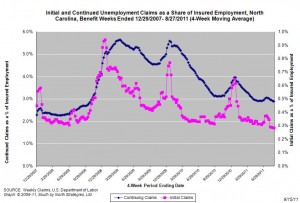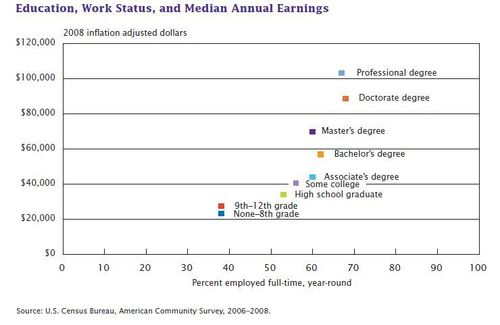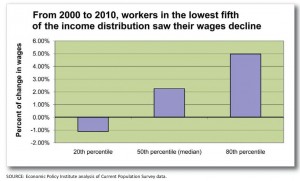15.09.2011
Policy Points
Economic policy reports, blog postings, and media stories of interest:
15.09.2011
Policy Points
For the benefit week ending on August 27, 2011, some 10,931 North Carolinians filed initial claims for state unemployment insurance benefits, and 105,974 individuals applied for state-funded continuing benefits. Compared to the prior week, there were more initial and continuing claims. These figures come from data released by the U.S. Department of Labor.
Averaging new and continuing claims over a four-week period — a process that helps adjust for seasonal fluctuations and better illustrates trends — shows that an average of 10,594 initial claims were filed over the previous four weeks, along with an average of 107,383 continuing claims. Compared to the previous four-week period, the averages of initial and continuing claims were lower.
One year ago, the four-week average for initial claims stood at 12,250 and the four-week average of continuing claims equaled 127,596.
While the number of claims has dropped over the past year so has covered employment. Last week, covered employment totaled 3.7 million, down from 3.8 million a year ago.
 The graph shows the changes in unemployment insurance claims (as a share of covered employment) in North Carolina since the recession’s start in December 2007.
The graph shows the changes in unemployment insurance claims (as a share of covered employment) in North Carolina since the recession’s start in December 2007.
Both new and continuing claims appear to have peaked for this cycle, and the four-week averages of new and continuing claims have fallen considerably. Yet continuing claims remain at an elevated level, which suggests that unemployed individuals are finding it difficult to find new positions.
15.09.2011
Policy Points
Random Samplings, the blog of the U.S. Census Bureau, traces the relationship between educational attainment and lifetime earnings. The graph below illustrates the relationships among educational attainment, median earnings, and unemployment.

14.09.2011
Policy Points
Economic policy reports, blog postings, and media stories of interest:
14.09.2011
Policy Points
A new brief from the N.C. Budget and Tax Center points out that the wages earned by North Carolina workers in the lowest fifth of the income distribution actually fell, after adjusting for inflation, between 2000 and 2010.





 Email Sign-Up
Email Sign-Up RSS Feed
RSS Feed